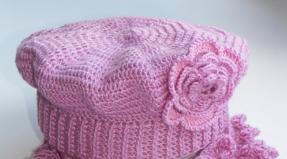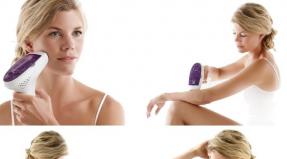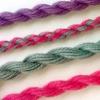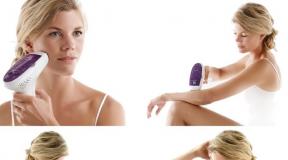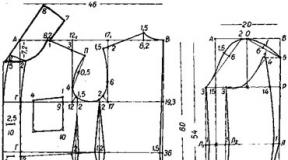Weaning from the Komarovsky pacifier. How to wean a child from sucking a pacifier correctly? We teach you to fall asleep without a pacifier. Is a pacifier harmful?
Since ancient times, many parents have used pacifiers to soothe their babies. They have become so firmly established in the everyday life of babies that many people often associate babies with the presence of pacifiers in their mouths.
Whether or not to use a pacifier for your baby is a decision made by parents; there are arguments both in favor of pacifiers and against them.
But if you are a pacifier addict, sooner or later you will be faced with the question of how to wean your child off the pacifier.
Many children easily part with this item, and for many, losing a pacifier even for an hour can result in prolonged hysteria, and then it will not be easy to wean the child off the pacifier.
Is it necessary to wean a child off a pacifier?
Naturally, a child will not suck a pacifier his entire life; not a single adult walks the streets with pacifiers. This means that sooner or later the child himself will refuse to use the pacifier.
But until this time, it can lead to bite problems and psychological difficulties, and it will be no easier to wean a three-year-old child from a pacifier than a one-year-old, and they will also point the finger.
Often parents want to quickly and radically wean their baby off pacifiers. Dangerous physical and prohibited psychological techniques are used, which can lead to health problems.
- dip the pacifier in mustard or pepper, hot sauces. This can cause burns to the mucous membranes of the mouth, esophagus and stomach, leading to poisoning
- tear or cut the pacifier. When sucking on such a damaged pacifier, a child may swallow or inhale pieces of it, he may choke and even die
- yell at the child for using a pacifier, spank and scold him
- tease the child, call him ugly names, shame the child (“oh, look how big the boy is and keeps sucking on the pacifier, wow, what a shame”).
- You shouldn't deceive your child. This will undermine the child’s trust in you and make parenting more difficult.
- scare the child with old women, Baba Yaga and other scary characters. Weaning from a pacifier is stressful for a child, and coupled with fear can lead to severe and profound neuroses.
Why wean off the pacifier?
The process of sucking for a child is one of the key reflexes inherent in nature, which is formed in the womb.
Through sucking, the child not only receives food, but also calms down, falls asleep, relieves stress, and copes with pain in the tummy and mouth.
Sucking is also a kind of psychological protection from experiences, a way of relaxation and receiving protection from the outside world.
Therefore, up to a certain point, sucking a pacifier for a child is a kind of habitual and constant way of calming and relaxing, from which a strong dependence can form if there is a lack of attention from parents.
If, during the period of weaning from the pacifier, you give the child maximum attention and switch in his mind the way of falling asleep and calming down to another, you can quickly refuse the pacifier.
Usually, artificial babies depend more on pacifiers; in infants, their replacement can be the mother's breast and communication and sleep with it.
When should you wean your child off a pacifier?
Children in the vast majority of cases wean off pacifiers at the age of one or two years, which is considered a fairly late time for weaning.
According to psychologists, a child needs a pacifier during the period of the most pronounced sucking reflex, approximately the first six months of life.
Therefore, it is recommended to gradually wean the child from the pacifier in the period from 6 months to 12 months, during the period of gradual fading of the sucking reflex.
It’s just important not to miss the moment when the baby is psychologically and physiologically ready to give up the pacifier, when he can get along just fine for some relatively long time without it.
Do not delay this process for too long and carefully monitor your baby.
It is impossible to indicate the exact age for giving up a pacifier; for all children this is strictly individual.
Try to go without using a pacifier for one day with your baby, starting from the age of six months - you will understand that a pacifier is mostly needed by parents, and not by children at this age.
Gradually teach your child to drink from a cup, give food from plates with spoons, this will gradually wean the child off the bottle nipple.
The sooner your child weans the habit of the bottle, the sooner he will wean himself of the pacifier.
It is worth distracting the child from the pacifier, developing his gross and fine motor skills, giving him various toys and rodents to play with. Do not remind about the pacifier yourself and do not give it to the child until he persistently asks for it.
Try to wean off it smoothly, taking longer and longer intervals between its use.
What to do during the period of weaning from the pacifier? Children at this age often cry, but this is not at all a signal for you to immediately give your child the treasured pacifier to calm him down.
Instead, try to distract your child with a game, sing a song or read a book, tell a fairy tale, feed the baby or rock him in your arms.
It is necessary to create a new ritual of calming the child, without the presence of a pacifier, which over time will crowd it out of the child’s life.
A pacifier should be left only as a last resort, when the child feels completely uncomfortable and difficult without it. At the same time, as soon as the baby calms down or falls asleep, you should remove the pacifier from him.
It should not be in the child’s field of vision; try to spend as much time as possible without it.
Stop taking it with you on walks, don’t give it while watching cartoons or doing activities with your baby, try to leave it only before bed, or even go to bed without it if possible.
For older children, explain that the pacifier is broken and you don’t have another one, cut the pacifier and give it to the child in this form. He may quickly lose interest in a damaged and uncomfortable pacifier.
You can also talk about little animals in the forest who really need a baby's pacifier. Often children willingly agree to give their pacifier to poor animals.
Try replacing falling asleep with a pacifier with a toy (doll, teddy bear, or any other favorite). Initially, you can fall asleep with a pacifier and a toy, gradually removing the pacifier.
Praise your child more often for being so mature and independent and for being able to do without a pacifier.
Many parents see learning to use a pacifier as a real salvation, since it calms the baby down and falls asleep faster. But the time comes when you need to wean yourself off the pacifier. In this article we will tell you how to wean your child off a pacifier or pacifier.
Why do you need a pacifier?
Until 6-7 months, the child actively wants to satisfy his sucking reflex. The best thing in this case is breastfeeding, which provides the sucking need in full. But children who are bottle-fed need a pacifier. In addition to a bottle with formula, an artificial baby will also need a nipple, which will help fully satisfy the sucking reflex. Of course, the child becomes capricious and cries if his sucking need is not fully satisfied. The whims go away as soon as the baby gets what he wants.
If the baby is not given his favorite pacifier, then fingers, cheek, and surrounding objects can be used, which the child can use to replace the pacifier. Dentists note that this habit is harmful, as it can lead to the development of serious malocclusion pathologies.
Following simple rules will help reduce the risk of developing pathological processes and preserve the baby’s correct bite.
When to wean a child off a pacifier
Attentive parents can see a child’s readiness to give up the pacifier at 3-6 months. When the first signs of weaning from the pacifier appear, you should take action. By six months, ideally, a child should learn to do without a pacifier: this is the opinion of modern pediatricians and dentists.
Experienced mothers and grandmothers often invent a variety of ways to wean their child off the pacifier. But there are several important aspects that should be followed if you want to wean your child off the pacifier:
- do not smear the pacifier with bitter seasonings and sauces to cause discomfort in the baby, as this can cause an allergic reaction;
- if you plan to wean your child off the pacifier as soon as possible, cut it like a chamomile, keeping in mind that the sharp edges of the petals can cause injury to the baby;
- Do not leave your baby without a pacifier if he is teething.
To wean your child off the pacifier, you need to choose the most successful time. The first thing we have already said is that you should not take away the pacifier if the baby is teething. A period of illness or any stress will also be unsuccessful. If you have weighed all the points and are observing a calm period in the life of the family and the development of the baby, you can take the following actions:
- If the baby falls asleep without a pacifier and does not require it while rocking, and also if he does not remember the pacifier until he sees this object, then there is no need to remind the child about it. As soon as you begin to notice that your baby is able to fall asleep without a pacifier, you can reduce the time he sucks while he is awake.
- When you are preparing your baby for bed, distract his attention with a variety of jokes, songs, and other activities that will allow the child to forget about the pacifier. It’s good if a pacifier becomes the last resort for getting your baby to sleep. Often the problem is that young parents do not have the patience to wait half an hour for the child to fall asleep on his own and they give the baby a pacifier. This forms in the child incorrect ideas about sleep rituals.
- During waking hours, try to hide the pacifier as far as possible from the baby. Let his entire consciousness be occupied with walks, games, and communication. Most children compensate for their parents' inattention with a pacifier, so try to spend as much time as possible with the baby.
If the baby is already one year old, then from now on you should understand the following: for a child after a year, a pacifier is no longer just a necessity - it is a toy, a friend, or at least an association with the moment of going to bed. A strong attachment to the pacifier creates psychological difficulties, so mothers should not listen to others who advise how to properly wean the child off the pacifier. It is difficult for a child to understand why he should give up his favorite item, why it suddenly became harmful, because before he received a pacifier from his mother’s hands, but today they give it less and less.
The most important rule for painless refusal is waiting for the right moment. When the baby is ready to part with the pacifier, you will need to act as quickly as possible, and first prepare the ground.
How to gradually wean your child off the pacifier
Psychologists say that a habit is formed in 21 days. What does this mean in this case? First of all, about the fact that it will take exactly that long for a child to get rid of a pacifier. Experts are confident that gradual pacifier abandonment is the best option and the least traumatic for the baby. How to smoothly wean a child off a pacifier?
- Firstly, give up the pacifier while walking and try to keep the baby without a pacifier during the daytime, that is, while he is awake.
- Secondly, focus on mastering the skill of drinking from a cup.
- Thirdly, before going to bed, put your baby’s favorite toy in the crib. This will help the baby avoid feelings of loneliness, which means he will be calm and will not need a pacifier.
- Fourth, be sure to wait until the baby falls asleep and do not leave him for some time. This will allow the baby to feel completely safe.
How to wean your baby off a pacifier in 7 days
There is a pacifier weaning technique that you should apply to your child for seven days. The essence of this express method is to give the baby a pacifier for the first five days half as often as before, and on the sixth and seventh days, give the baby a pacifier only before bed. You can alternate between breast and pacifier.
It is worth noting that if a baby is going through exciting moments, then he needs a pacifier as a soothing one. If the baby is not particularly capricious, then you should not shove this pacifier unnecessarily.
If you see that your baby is experiencing discomfort without a pacifier, you can give him a pacifier for a few minutes and then replace it with a breast.
Quickly weaning your baby off the pacifier
You can abruptly wean your child off the pacifier. The technique is to take away the baby's pacifier once and for all. Of course, whims and tears are possible, but this will allow you not to prolong the process.
Abrupt disposal of the pacifier is best suited for babies over one year old.
Prepare your baby to give up the pacifier; there are many ways to do this:
- Children love when they are told fairy tales in which they themselves are the main characters. Tell your child a story about helpless babies to whom a brave child gives his pacifier and thereby saves them. If fairy tales do not give results, you should “forget” the pacifier at a party and see how the baby reacts to this. If the child fusses, then the loss must be returned.
- It is not advisable to give your child a pacifier while falling asleep. Distract the baby from the object, hide it from sight. But if a child demands a pacifier, you should give him what he wants. Try to replace the pacifier whenever possible, regardless of the child’s emotional state and his time spent. Put all your problems aside to spend as much time as possible with your baby. Often a baby uses a pacifier to get rid of boredom, stress, problems, and loneliness.
- Other psychological techniques include fulfilling a wish in exchange for a pacifier. You can talk about a fairy who, in a corner of the house, takes a pacifier in exchange for something the child would like to receive. Thus, the baby initiates parting with the pacifier, so he will not be offended by you if he is left without it.
- You can cut off small pieces from the pacifier and tell the child that these animals are taking the pacifier for their babies. Soon all that will be left of the pacifier is a ring and the child will get tired of using the remnants of his once favorite pacifier.
- You can ask your child to give his pacifier to children who are much younger in age. Explain to your baby that younger children need a pacifier more.
Such simple activities will help wean your child off the pacifier with minimal trauma. At the same time, be prepared that the baby will wake up at night, cry, and ask for a pacifier. To calm your child down, talk to him, sing a lullaby, stroke him, or maybe give him some water to drink.
If you notice your baby's moodiness and emotional instability for several days, buy him a new pacifier and postpone the experiment for a while. It is worth noting that most children simply forget about the pacifier by the age of two or three.
If you observe the baby's dependence on the pacifier, then you will have to make every effort to wean the child off the pacifier.
It is not recommended to take away the pacifier, prohibit finger sucking, or be in the baby's arms. You and your doctor can choose a vestibular plate. It is made of elastic plastic, but the design of the plate is very similar to a pacifier. The record is suitable for children from 3 years old, and for younger children “Stoppy” is a substitute for the record. Its design is characterized by the presence of linings made of silicone. This promotes comfort and ergonomic placement in the mouth. In addition, “Stoppi” also performs a healing function.
How to wean a child off a pacifier using Stoppi?
The “Stoppie” vestibular orthodontic plate can be one of the life-saving solutions if you have tried many ways to get rid of the pacifier. The plate is made of hypoallergenic silicone. According to the manufacturers, it allows you to get rid of the pacifier and correct the bite.
Other benefits of the plate include the prevention of problems with the development of the lower jaw, as well as the elimination of mouth breathing.
A positive result can be obtained within a month. At the same time, it is important that the baby does not put a pacifier or finger in his mouth.
Naturally, a preliminary consultation with a dentist is required. It is a specialist who can determine the need for such a plate for a child.
Psychological aspects of weaning from the pacifier
Oddly enough, behind sucking a pacifier there is a psychological moment of habit and comfort. Psychologists name several important reasons that prevent a child from parting with a pacifier:
- the need for parental attention and care (first of all, we are talking about a lack of communication and a lack of parental love);
- the baby does not want to become an adult, so it is very important to talk with the baby, explain to him that he has already grown up, and you can also replace the pacifier with a more interesting activity;
- stress contributes to the fact that a child who has lost the habit of using a pacifier begins to suck on it again, most often this happens if the baby goes to kindergarten - the pacifier helps him remember about home and his mother;
- Stop bottle feeding your baby to minimize the association associated with the pacifier.
Naturally, every baby demonstrates its own character from the first months of life, so sometimes it becomes difficult to wean a child off a pacifier. At the same time, it is necessary to look for an approach to the child, and if necessary, contact a psychologist. In any case, your actions must be deliberate so as not to injure the baby and weaning off the pacifier takes place with minimal consequences.
What not to do?
Many mothers and fathers make the same mistakes, so it is very important to know what actions only aggravate the situation. So, what should you not do if you decide to wean your baby off the pacifier?
- Do not wean your baby off the pacifier if he is capricious, feels unwell, or there have been changes in his life, for example, he is getting used to kindergarten;
- If your baby is possessive by nature and is very attached to the pacifier, then you should not teach it;
- Do not humiliate the child, do not call him a crybaby or a crybaby;
- If you are offering a gift in exchange for a pacifier, don't let the gesture become traditional;
- If your baby is teething, you should not wean him off the pacifier, as this will cause additional discomfort for your baby.
Video: Pacifier: pros and cons
For many mothers, a pacifier (pacifier) becomes a real salvation in the first months of a newborn baby’s life. The baby falls asleep easier with it, worries less and is capricious. But children become so attached to their “friend” that sometimes they continue to use a pacifier even at two and three years old. Naturally, this is not a very useful habit at this age, and parents try to gradually remove and wean the child from the pacifier in every possible way. But all methods are suitable for the child’s fragile psyche, and in order to choose the most optimal option and the right time for weaning off sucking the pacifier, it is necessary to take into account the baby’s character and follow the advice of pediatricians.
The benefits and harms of pacifiers
Smoothly giving up your favorite pacifier involves getting rid of the habit in a few weeks. This method is more suitable for babies under one year old and a little older. Gradual withdrawal involves following these tips:
- Don't take your pacifier on a walk;
- During the daytime, move the pacifier away;
- Teach your baby to drink from a cup as much as possible () ;
- Come up with new exciting games and entertainment for him;
- While sleeping, you can put your favorite toy in the crib, so the baby will understand that he is not alone and will devote less time to his old girlfriend;
- When falling asleep, wait until the baby falls asleep; you do not need to leave him at this time.
Weaning scheme for a week
- For the first 5 days, give the pacifier half as much time as usual.
- For the next few days, give the pacifier only at night (and during naps).
- Reduce the time to fall asleep with a pacifier by half, giving the breast after the pacifier.
- Give the nipple for a few minutes - then the breast.
You should give your baby a pacifier only in those difficult moments when he really cannot calm down without it.
Abrupt refusal
This method is suitable for children aged one and a half years and older, that is, for those who already understand their mother and can understand what she is explaining to him.
Abrupt refusal of the pacifier means once and for all!
But the baby must be prepared for this. And there are many effective ways for this; depending on the child’s character, each mother will be able to choose a convenient and optimal option. 
- You need to give a pacifier to someone. Ideally, for a newborn baby - a neighbor or relative. Your son or daughter already understands that they are getting older, and the little one needs a pacifier. It must be said that nipples are necessarily passed from older to younger, and for an even greater effect, you can organize a moment of ceremonial transfer from hand to hand (of course, as a joke);
- You can " send to a little bunny in the forest or a fish in the sea". Your baby needs to be told that animals are afraid in the forest and only a pacifier can protect them;
- For some children, the method of throwing it into the sea, a car window, a train, or simply into the trash is suitable;
- After getting rid of the pacifier, the baby should definitely be given a good gift, emphasizing the fact that only large and independent children play with such toys.
After getting rid of the pacifier, you need to endure the baby’s whims for several days. Perhaps he will wake up at night, cry and demand a pacifier.
;P.S. How to wean a baby off the bottle link at the beginning of the article :)
Pediatrician's opinion (video)
Parents' experience
A pacifier plays a big role for a baby - with it he calms down, falls asleep easily, and realizes his sucking reflex. However, at one point parents will have to wean the baby from this subject.
When should you start and how to do it correctly so that separation does not cause psychological trauma to the child?
Pacifiers help babies calm down by reminding them of the prenatal period when they sucked their fingers. It is not surprising that a bad habit forms very quickly, but weaning from a pacifier becomes a truly serious test for the whole family.
When should you wean off the pacifier?
There is no exact answer to this popular question. The time of weaning must be selected individually, since children differ from each other in their physiological and mental development.
Only a mother who is constantly with the child can choose the optimal age.
Some babies refuse the pacifier at 6-7 months, when parents begin introducing the first solid foods. Most often, children part with this childhood attribute at one and a half years old without much tears or suffering. But sometimes mothers have no idea how to wean a three-year-old child off the pacifier.
The main thing in the weaning process is not to harm the child’s psyche.
Therefore, adults should determine the optimal age based on their own feelings, and also choose the best method of refusal - gradual or abrupt.
How to wean a child off a pacifier?
When choosing a refusal method, it is better to consult a pediatrician. Recommendations from grandmothers and mothers you know may not be suitable for your baby.
Psychologists name two main methods for weaning children from this seemingly harmless subject:
- Smooth weaning - more suitable for babies from six months to one and a half years, lasts up to eight weeks, depending on the type of temperament and other characteristics of the baby.
- Abrupt refusal is the best way for children aged 1.5 years and older; mothers will have to use all their imagination so that the baby can give up his addiction.
Knowing the characteristics of their children, adults can choose a less traumatic method of getting rid of the habit, but they should not delay solving the problem.
Of course, a child will not go to school with a pacifier, but this will require a lot of effort from adults. The main thing is not to turn the process into an uncompromising struggle and not to put pressure on the baby.
Rules of disposal - weaning off the pacifier
So, an important role in this process is played by the age of children, their psychological characteristics and reaction to the actions of their parents.
We present several basic rules that should be applied when weaning children from their addiction to the pacifier.
- Don't yell at your little ones if they refuse to comply with your requests and continue to demonstratively use the item.
- Try to make the refusal procedure fun to reduce anxiety and relieve your child of stress and resentment.
- Explain in detail to your growing child that at his age it is already possible to give up the pacifier. Show photos of happy children without pacifiers, but be careful when comparing them to peers.
- Do not use old, time-tested and grandmother-tested methods - lubricating the surface with aloe juice, garlic, hot pepper, mustard. Spices may cause an allergic reaction.
- Create a daily routine in such a way that the baby is constantly busy - play educational and active games, do physical exercises.
- Create a special ritual before bed to avoid hysterics during weaning: water treatments, reading a book, light massage, etc.
- Does your child fall asleep with “suckers” in his mouth? Be sure to take it out and place it nearby to avoid sucking in your sleep.
- Do not cut the pacifier, otherwise the baby will be able to bite off a piece of latex and thereby cause digestive problems.
- It is strictly forbidden to spoil an object that is important to children in their presence, so as not to cause psychological trauma.
Weaning children under one year old from pacifiers
To get rid of a bad habit without notice, you will need to put in a lot of effort, since babies are quite jealous of their toys.
- Adopt a smooth weaning technique, showing the pacifier to your baby as little as possible. Then he will quickly forget about her existence.
- Feed your baby more often so that he does not pull the pacifier into his mouth. Get a relaxing massage and water treatments every day.
- Before falling asleep, read fairy tales, poems, and various nursery rhymes to your baby. Provide a new “sedative” – a soft teddy bear.
- Distract a crying baby with some kind of treat, a bright toy: cubes, a pyramid, a car.
This process can last up to two months, but children will be calm and by the age of one year they will have learned to completely do without a pacifier.
How to wean a two-year-old child from sucking a pacifier?
You can give up a popular childhood attribute at two years old with the help of a fascinating and touching story, in which the main character will be a familiar newborn or a neighbor’s baby.
With all your emotion, tell your child that he no longer needs a pacifier, since he has grown up, but tiny babies are really looking forward to a pacifier.
Usually this simple trick works, and the child himself solemnly hands over his favorite item to the other toddler. True, by the evening he may change his mind, demanding “suck” back.
In this case, try to distract your kind and generous baby with a new toy.
If you have not found a suitable candidate to present the treasured pacifier, call on your imagination to help - dogs in the yard and animals from the magical forest are suitable for the role of “receiver”.
Weaning a three-year-old child off a pacifier
For various reasons, using a pacifier can take up to three years. Although this is not considered a developmental disorder, it is necessary to get rid of the unpleasant habit, especially if the baby will soon go to kindergarten. At this age, the refusal should be sharp, final and irrevocable.
- First, tell your child that he is already big and from now on he will not use a pacifier. The explanation should be short, clear, and delivered in a calm, confident voice.
- Secondly, try to discreetly lose or throw away the pacifier. After that, tell him that there is nothing to replace it with, and no one will sell a new one to such a big boy or girl. Be sure to buy a tasty treat or a long-awaited toy to help your baby cope with the loss.
Children are the most precious thing that can be in the life of any person; every day they discover new knowledge, habits and weaknesses are formed, which are not always easy to part with later.
A pacifier or pacifier is a favorite accessory for babies of any gender, but sooner or later the child will have to give up this toy, and it is best to do this competently and painlessly for the psyche. Most young parents ask themselves questions: when should they wean off the pacifier, how and why?
Why does a baby get used to a pacifier?
It is quite difficult to give an unambiguous answer to this question, because each child is an individual, so it is not possible to unlock thousands of doors with one key. Why babies quickly get used to nipples and have such a hard time parting with them is all very simple – basic instincts.
The baby associates the pacifier with the mother’s breast, and therefore causes tenderness and a desire to take it into the mouth. Most toddlers fall asleep well only with a pacifier, and stop being capricious and mischievous only when the treasured trifle gets into their mouth.
For many mothers, using pacifiers is an excellent solution to the problem of a restless child, but if difficulties or whims arise, you should not constantly shut up the baby’s mouth. Some pediatricians believe that frequent use of pacifiers leads to developmental disorders, as well as the formation of an incorrect bite. However, confirmation of this theory has not yet been presented, although you will agree that it would be strange to see a schoolchild with a healthy psyche and a pacifier in his mouth.
That is why it is best to wean a baby off a pacifier at an early age, preferably before two years of age; it will be easy and safe for the child’s psycho-emotional health.
Methods of refusal
Most experts come to the conclusion that quick adaptation to the pacifier occurs not only because it resembles a mother’s breast, but also gives the baby a feeling of confidence, calmness and satiety. It is quite difficult to take away a sense of peace from a baby, but parents should still be prepared for a number of difficulties that will arise when giving up this habit:
- the child becomes whiny, irritable and aggressive.
- possible frequent whims, tears and demands to return your favorite toy.
- no long-term sleep problems.
- The baby will look for replacement, so there is a possibility of frequent feeding.
- the likelihood of oral infections increases due to the child’s constant desire to put various toys, blankets or pillows in his mouth.
It is worth noting that breastfed children should not be given a pacifier until the baby begins to eat enough milk. An increased sucking reflex can lead to the fact that the baby simply does not have enough breast milk, and he begins to require a replacement in the form of a nipple. Be very attentive to the issue of replacing your mother's breasts with an artificial analogue. When choosing a way to give up a pacifier, it is best to use proven methods or consult with specialists, but today there are two basic techniques for weaning a child from a pacifier:
- Smooth weaning Suitable for children from six months to one and a half years. This method takes approximately 1-2 months, depending on the individual characteristics of the child’s character.
- For children aged 1.5 years and older, the best way to wean is sharp, lightning-fast refusal of the pacifier. Parents must use all their imagination to ensure that the child himself leaves the addiction here and now.
Knowing the character and interests of their baby, parents can choose the most gentle way to refuse a pacifier, but it is best not to delay resolving this issue. Many children at the age of three throw away their pacifiers on their own and never return to them, but before this you need to have long conversations and tell the baby why you need to part with the toy you like.
Most often, it takes parents a lot of effort to get rid of pacifiers and correctly tell their children that they no longer need this accessory. The most important thing is not to turn this process into a struggle and not to put pressure on the baby.
10 ways to get rid of pacifiers for children of different ages
Each baby has its own characteristics, so it is quite difficult to apply general rules of action; it is necessary to carefully monitor the child’s reactions to various actions, in addition, age plays a significant role. There are several basic rules that must be followed when weaning a baby from a pacifier:
1. Tell your child in detail that at his age it is already possible to do without a pacifier, justify your story with examples, pointing to children his age.
2. Turn this procedure into a game so that the child does not worry and is not subject to stress and resentment.
4. Do not use various oils, jams and other edible mixtures with an unpleasant taste for coating the pacifier.
5. Spend enough time on conversations, educational games, music training and singing.
6. Create a daily routine in such a way that there is simply no time left for pampering and whims; the child must be physically active.
7. Before going to bed, be sure to bathe your baby in cool water, this will help avoid hysterics before bed and will perfectly replace a pacifier.
8. If your baby falls asleep with a pacifier in his mouth, be sure to take it out and place it nearby so that during sleep there is no desire to suck on something.
9. Do not damage the pacifier in front of the child, this can lead to psychological trauma.
10. Do not cut the daisy-shaped pacifier; the baby’s mouth already has sharp teeth and he can bite off a piece of rubber, which will cause digestive problems.Using these basic rules, you can avoid most mistakes, and giving up a pacifier will be painless and quick, however, there are more effective methods for children of different ages.
Refusal of the pacifier before the age of 1 year
In order for the baby to refuse a pacifier before the age of one year, it will be necessary to spend quite a lot of effort and time, because at this time the child is quite jealous of toys and habits.
It is best to use the technique of smooth refusal, that is, create such conditions for the child that he simply forgets about the existence of the pacifier.
Feed your baby well so that he does not have the desire to occupy his mouth with a pacifier, be sure to carry out water treatments and a relaxing massage every day.

Read fairy tales to your toddler before bed and carefully monitor reactions to the absence of a pacifier, try to use this accessory as little as possible and over time the child will give it up on his own.
It is necessary to constantly distract the child from the pacifier with various games and conversations; this procedure may require from 4 to 8 weeks, but the result will be impressive. At the age of one year, a child will already be able to do well without a pacifier and this will not affect his healthy sleep in any way.
How to wean a child off a pacifier at 2 years old
With older children the situation is much simpler. You can give up a pacifier at two years old using a unique technique called “personal example.” You should tell your baby an exciting story involving a neighbor's baby or little brother who just needs a pacifier but doesn't have one.
A two-year-old child needs to be clearly explained that he no longer needs a pacifier as much as the baby in your story does; the most important thing is that this object is real. If you don’t have any suitable candidates in mind for the role of the receiver of the treasured pacifier, use your imagination - fish in an aquarium or chicks in a nest, any living creature of a suitable age.
Weaning a 3 year old child
Not all parents pay attention to pacifiers, so many children at three years old still use pacifiers. Of course, this is not a developmental disorder, but it’s worth thinking about it and starting to wean your child off this habit. In this situation, giving up a pacifier at three years of age should be immediate, final and irrevocable.

You just have to tell your child that from this day on he will no longer use the pacifier, because he is already an adult and he does not need it. The answer should be clear, concise and in no case traumatize the child’s psyche.
It is best to artificially create a situation where the pacifier is lost or deliberately thrown away, that is, it can no longer be returned, so you need to live in a new way. After the object is thrown away and the baby understands that it is no longer there and cannot be replaced, you need to buy a sweet treat or an interesting toy to encourage the child’s efforts. This method is currently effective and fast, although it is only suitable for adult children.
Using this knowledge and scientific developments, every parent will be able to make the right choice in favor of one method or another. The main thing is to carefully observe your child and find the right words to explain to him the need to give up the pacifier.
